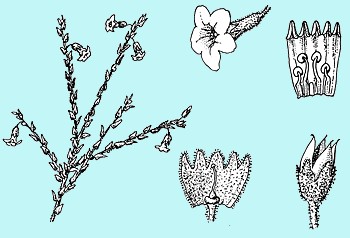
Synonymy
Cyphanthera miersiana Haegi, Telopea 2: 177 (1981)
T: 25 km E of Wiluna, W.A., 22 Oct. 1966, C.A. Gardner 19061; holo: PERTH; iso: AD, MO.
Description
Erect shrub to 70 cm. Branches moderately pubescent with mainly simple, glandular and non-glandular hairs.
Leaves triangular-cordate, sessile, 3–4 mm long, 2–2.5 mm wide, pubescent.
Flowers solitary or in few-flowered cyme-like groups; pedicels 4.5–7.5 mm long. Calyx 4–5 mm long, densely glandular-pubescent. Corolla 6–10 mm long, almost glabrous outside, white, the striations purple; lobes broadly ovate to orbicular, 2–4 mm long. Stamens 4–5 mm long.
Capsule ovoid-ellipsoid, apiculate, 4 mm long. Seeds not seen.
Distribution and ecology
An uncommon species endemic to the Wiluna area, W.A.; grows on sand dunes.
Selected specimens
W.A.: near Uramurdah Creek, L. A. Craven 5266 (A, AD, BRI, CANB, G, K, L, LAE, MO, NT, P, PERTH, PRE, RSA); Kathleen Valley Reserve, 1971, S.J.J.F. Davies s.n. (PERTH).
Derivation of epithet
Named for John Miers (1789-1879), British botanist and collector who wrote widely on South American plants.
Images and information on web
Further information for this species in WA can be found on the FloraBase site.
Pharmacology: A discussion of the tropane alkaloids which occur in Cyphanthera and other Anthocercideae can be found in Griffith & Lin (2000).
Ref: W.J. Griffin & G.D. Lin (2000). Chemotaxonomy and geographical distribution of tropane alkaloids. Phytochemistry 53: 627–628.
Plant status (if any)
Without any declared rating in W.A. – see http://florabase.calm.wa.gov.au/conservationtaxa